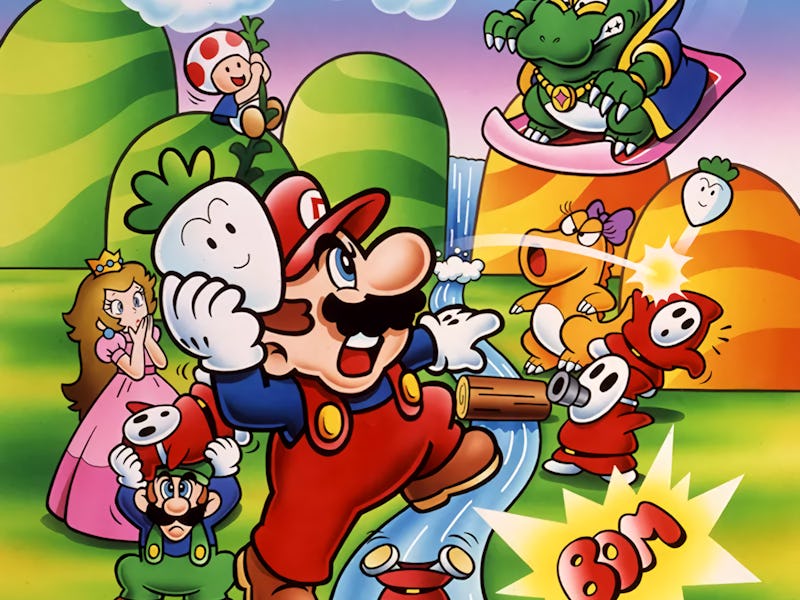You need to play the most controversial Mario game on Nintendo Switch ASAP
This is a strange deviation from the regular Mario model.

In 1988, the first-ever cover of Nintendo Power magazine featured Super Mario Bros. 2, the company’s next major game. In a delightful clay still life, Mario is seen bounding over a toadstool and holding a radish as the game’s antagonist — the evil toad Wart — watches on.
It was the first time Western gamers learned that there would be a sequel to the incredibly popular Mario game. They had no idea what a long, odd road the game had taken before reaching their living rooms. Needless to say, gamers bought it en masse, and it helped further establish Mario as one of the biggest franchises in gaming.
If you’re a paid Nintendo Switch Online subscriber, you can play Super Mario Bros. 2 right now by downloading the Nintendo Entertainment System app.
Mario looks much better with a red hat.
Super Marios Bros. 2 is a fun game to play, especially with a friend. It’s something of an anomaly in the franchise. The game allows for more character choice than other pixel-era Mario games, adding Peach and Toad into the mix. The game also doesn’t play like other Mario games with jumping on shells and mushrooms. Instead, you have to pick up radishes from the ground and toss them at enemies.
At the time of its release, as noted by a video from the channel Gaming Historian, this wasn’t seen as much of a big deal. Game companies experiment with their properties all the time. But when Super Mario Bros. 3 was released these changes were scrapped. SMB 3 solidified the popular conception of Mario gameplay: jumping, shells, question mark blocks.
The advent of Super Mario Bros. 2 is one of the first moments where video game companies began to realize that their markets around the world were not universal. Different gaming cultures wanted different things out of games. In looking to create a Super Mario sequel, Nintendo first looked for inspiration in the closest thing available: its rejiggered version of the first game which was put in arcades. The main difference? That game was much harder — in order to better take player’s money.
Look at Toad go!
Playing through the harder version, Nintendo employees found that they actually enjoyed the new challenge. In an effort of increasing the difficulty of the first game but not changing much else, a sequel was born and released in Japan in 1986. The game was a smash hit.
Flashback six years to 1980, when Nintendo first started its Nintendo of America subsidiary. While Nintendo of America makes its capital Manhattan, it gets games from Japan sent to Washington state. Just outside of Seattle, a man named Howard Phillips got a job through a friend managing Nintendo’s warehouse and shipping arcade cabinets. But more than just a warehouse manager, Phillips became a go-between for American players and Japanese executives and game-makers. Talking to people at arcades, Phillips understood what players did, and did not, like about each particular game.
All of this was a godsend to the founders of Nintendo of America, frat bro salesmen, and relatives to Nintendo employees who did not play games naturally. Phillips quickly rose the company, advising Mario and Zelda creator Shigeru Miyamoto on potential American reactions to games.
Nintendo’s official montage for Super Mario Bros. 2.
When the Japanese version of the Mario sequel got into Phillips’ hands, he expressed a worry like never before. This game was far too challenging for the American player, who was likely far less experienced than a Nintendo employee. Nintendo trusted Phillips, choosing to reskin a game that had long been seen as familiar to Mario games, Yume Kōjō: Doki Doki Panic.
Initially made to integrate vertical climbing into a Mario-style game, Yume Kōjō or less became a Mario game. While Miyamoto was involved in both games, the injection of a new franchise into the world of Mario made for some striking oddities.
Just because SMB2 is an outlier doesn’t mean it didn’t leave a mark on future Mario games. Enemies that were never meant for Mario, like Shyguys and Bob-ombs, became series regulars. Recurring miniboss Birdo eventually began switching sides. Other enemies, like the pesky Phantos that follow around the player-character whenever they hold a key needed for unlocking a door, are among the most frustrating to pass in any Mario game.
Not everything works in SMB2. At times, picking up radishes over and over can feel a little repetitive. It makes sense that the series would return to its definitive play style after this one, but SMB2 has charms entirely of its own that feel like a relic of a lost era — or an alternate path that Mario could have taken.